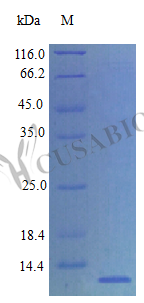Recombinant Rat BRAK protein (Cxcl14) is produced using an E.Coli expression system and contains the complete mature protein sequence from amino acids 23 to 99. The protein appears to maintain high purity—greater than 95% based on SDS-PAGE analysis—and comes without any purification tags. Biological activity has been confirmed through chemotaxis bioassays with human monocytes, showing responsiveness at concentrations between 1.0 and 10 ng/ml. Endotoxin levels stay below 1.0 EU/µg, as determined by LAL method testing.
BRAK protein, which goes by the alternative name Cxcl14, functions as a chemokine within immune system pathways. Its primary role seems to involve chemotaxis—essentially guiding the directional movement of monocytes, those crucial white blood cells that help orchestrate immune responses. Being part of the CXC chemokine family, Cxcl14 has drawn considerable attention from researchers studying how immune cells migrate and how inflammation develops.
Potential Applications
Note: The applications listed below are based on what we know about this protein's biological functions, published research, and experience from experts in the field. However, we haven't fully tested all of these applications ourselves yet. We'd recommend running some preliminary tests first to make sure they work for your specific research goals.
1. Human Monocyte Chemotaxis Assays
This recombinant rat BRAK/CXCL14 protein is confirmed to be biologically active in human monocyte chemotaxis (active at 1.0-10 ng/ml) and suitable as a positive control. However, researchers should validate its activity in rat-specific monocyte populations to confirm that cross-species reactivity is consistent. The high purity (>95%) supports reliable dose-response studies, but optimal concentrations may need adjustment for primary rat monocytes due to potential species-specific receptor affinity differences.
2. Comparative Chemokine Function Studies
The protein enables valid comparative studies with human BRAK/CXCL14, but the unknown receptor identity for BRAK limits mechanistic comparisons. Researchers should focus on functional potency comparisons rather than receptor-binding studies. The cross-species activity suggests evolutionary conservation, but structural differences may affect detailed structure-function analyses.
3. Antibody Development and Validation
This high-purity, full-length mature BRAK (23-99aa) serves as an excellent antigen for antibody development. However, antibodies should be validated against native rat BRAK from biological sources to ensure recognition of physiologically relevant forms, as E. coli expression lacks mammalian post-translational modifications that may affect some epitopes.
4. Protein-Protein Interaction Studies
The biologically active BRAK is suitable for interaction studies, but the unknown receptor identity makes targeted binding studies challenging. Researchers should use unbiased screening approaches and validate any identified interactions with full-length protein. The partial sequence may lack domains important for some interactions.
5. Structure-Function Relationship Analysis
This protein provides a good reference for structure-function studies, but the full-length mature protein (23-99aa) representation should be confirmed against native BRAK processing. Mutagenesis studies should account for potential differences in protein behavior compared to native forms, particularly regarding receptor binding domains that remain poorly characterized for BRAK.
Final Recommendation & Action Plan
This recombinant rat BRAK/CXCL14 protein demonstrates excellent biological activity in human monocyte chemotaxis, making it suitable for the proposed applications with appropriate validation. First, establish rat-specific activity profiles using primary rat monocytes to complement the human cell data. For comparative studies, focus on functional potency comparisons rather than receptor-mediated mechanisms until BRAK's receptor is identified. When developing antibodies, validate cross-reactivity with native BRAK from rat tissues. For interaction studies, employ proteomic screening approaches rather than targeted receptor studies. The high purity and low endotoxin support cell-based applications, but researchers should note that BRAK's unusual receptor independence may lead to unique behavior compared to classical chemokines. Always include appropriate species-matched controls and consider that the 1.0-10 ng/ml activity range may vary across different cell types and assay formats.






